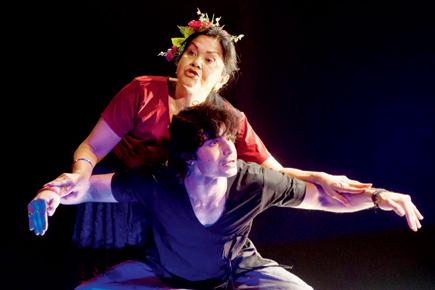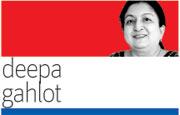Mumbai’s theatre scene is the most vibrant, there is no argument about that, but sometimes you can’t but notice the complacency seeping in

 Mumbai’s theatre scene is the most vibrant, there is no argument about that, but sometimes you can’t but notice the complacency seeping in. The mainstream theatre practitioners know what their audience wants and deliver it; audiences in turn are willing to pay large sums of money to see either a film/TV star on stage or an entertaining comedy.
Mumbai’s theatre scene is the most vibrant, there is no argument about that, but sometimes you can’t but notice the complacency seeping in. The mainstream theatre practitioners know what their audience wants and deliver it; audiences in turn are willing to pay large sums of money to see either a film/TV star on stage or an entertaining comedy.
The experimental theatre gang works hard and with utmost sincerity but is always stymied by the lack of funds. Still, what they do with limited resources and little support from sponsors is admirable.
ADVERTISEMENT
 Visually arresting: Chandigarh-based Neelam Mansingh brought her Punjabi play The Last Tale to Mumbai, and even those who could not follow the language could not but be drawn into the strange, poetic, mystical world that the director created
Visually arresting: Chandigarh-based Neelam Mansingh brought her Punjabi play The Last Tale to Mumbai, and even those who could not follow the language could not but be drawn into the strange, poetic, mystical world that the director created
So, once in a while, Mumbai audiences have to see what theatre companies from outside Mumbai are able to achieve in terms of stagecraft, working with well-trained actors and technical crew. Chandigarh-based Neelam Mansingh brought her Punjabi play The Last Tale to Mumbai, and even those who could not follow the language could not but be drawn into the strange, poetic, mystical world the director created, with lighting, music and props that included slabs of ice, flowers, cutlery and a plastic sheet.
Mansingh is one of the finest theatre directors in the country today, whose productions are visually arresting, retain a uniquely Punjabi sensibility that makes them pan-Indian as well as global, since all work done with conviction is capable of crossing cultural and linguistic boundaries. She started her group, The Company in 1983 and though she is headquartered in Chandigarh, her plays are watched and admired by theatre lovers everywhere. Mumbai audiences still remember the splendid Kitchen Katha, during which the actors actually cooked up a feast that was served to people in the theatre after the play.
The genesis of The Last Tale is interesting, Toni Morrison (Novel Prize-winning author) wrote a play called Desdemona, because she felt in Shakespeare’s Othello, the woman didn’t get a say — she was killed two days after her wedding to Othello, being suspected of infidelity, which she could not possibly have committed. Morrison’s play centred around the bond between Desdemona and the nurse who raised her.
Mansingh took the germ of that idea and created Bihaag who is killed by her husband Udhav, who then commits suicide. They meet in the graveyard after death and are able to talk, which they hadn’t done in the throes of passion and their tragically brief marriage, after she chose the blacksmith’s son in a swayamvar to which he wasn’t even invited due to his lower caste.
Interestingly, both Bihaag and Udhav are played by Vansh Bhardwaj, whose expressive face and lithe body worked wonderfully well without being blandly androgynous; he also played multiple parts with Gick Grewal. Mansingh uses Punjabi folklore (which is full of tragic love stories like Heer Ranjha and Sohni Mahiwal), and gives the production a dream-like feel (Daulat Vaid richly evocative light design), using an abstract and ritualistic style. (On an earlier journey, all the props, costumes and musical instruments of this production were stolen in a train, but Mansingh and her troupe, put it all together again impeccably.)
It’s pure theatre that fuses all the elements into a mesmerising piece, which, admittedly, baffled many South Mumbai viewers, whose exposure to artistic theatre is somewhat limited.
Still, it is important for performing artistes to challenge their own boundaries. Shiamak Davar’s Selcouth is an
example of a dancer-choreographer-teacher, getting out of his popular Bollywood dance mode and create a piece of work of amazingly energy and beauty. Most of the dancers in the show have been training with Davar for just a year, but have that flexibility, weightlessness and chiseled bodies of ballet dancers.
After the first show with the students’ family and friends, Davar was requested to take this work to the public, and Selcouth has turned into a success, which does not happen too often with contemporary dance. Davar uses an audio-visual to exhort people to speak up against violence towards women, which then gives the dances in Selcouth an edgier feel.
The dancers are dresses in minimal white clothing, and all wearing bald wigs. Even though their bodies are exposed, there is nothing sexual about the dancing. With the lighting and a few props, what comes to mind is a sci-fi film with androids. Davar calls it spiritual and it is in a way. Some moments — like the one in which the masses of dancers bunch together like a giant predator and ‘devour’ a body — are absolutely stunning.
The choreography is a blend of ballet, Bollywood, western contemporary dance and in the finale, a dash of Kathak with the dancers all doing a frenzied ‘tatkar.’ Davar is evidently an excellent teacher and has got himself a fine team to manage his vision. After Selcouth, he has entered an experimental space, and we are curious to know what he does for an encore.
Deepa Gahlot is an award-winning film and theatre critic and an arts administrator. You can follow her on twitter @deepagahlot
 Subscribe today by clicking the link and stay updated with the latest news!" Click here!
Subscribe today by clicking the link and stay updated with the latest news!" Click here!







